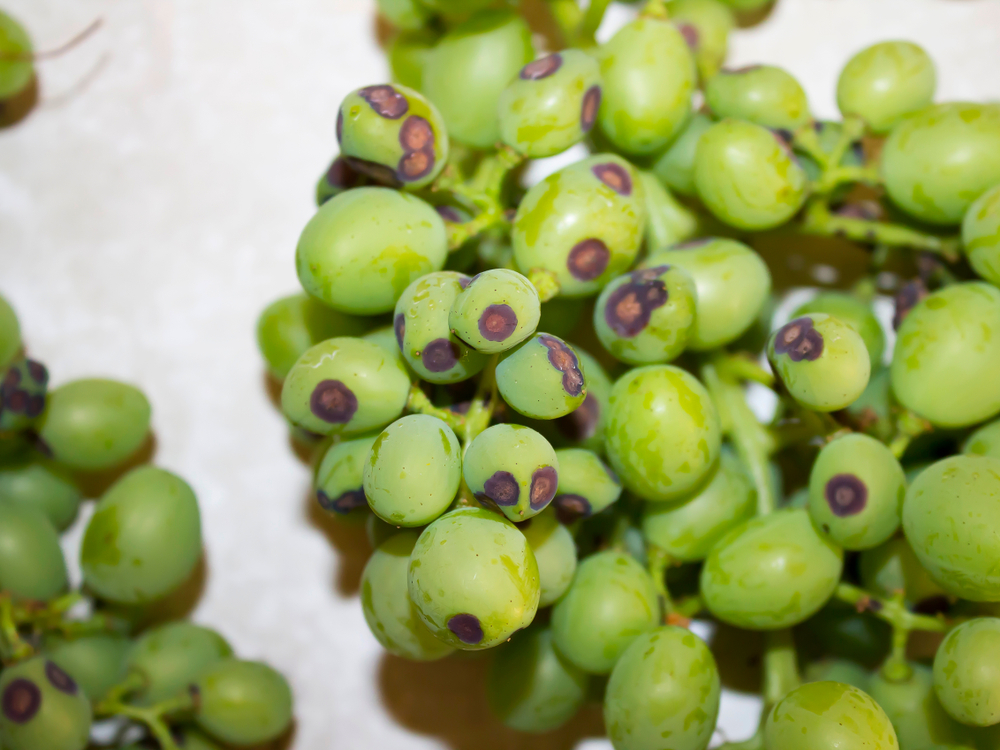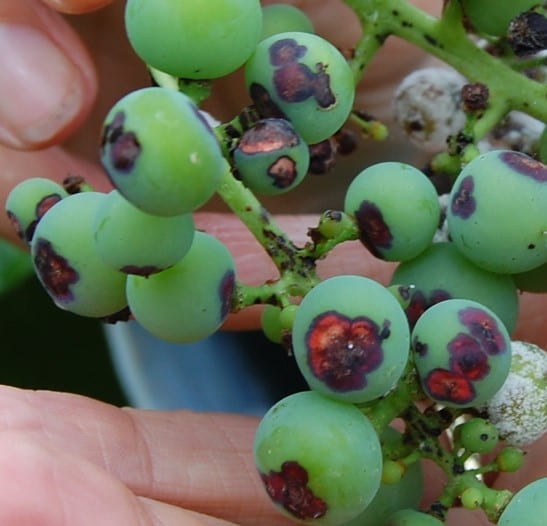
Antracnosis
WHAT IS AND HOW TO ELIMINATE
Anthracnose
Elsinoe Ampelina (Glocosporium Ampelophagum)
Pathogen:
Fungus
Type:
Risk to the plant:
HIGH



DESCRIPTION
WHO CAUSES IT?
Elsinoe ampelina is an ascomycete fungus, responsible for the disease known as anthracnose of the vine. This pathogen has a characteristic life cycle in which it goes through several stages, beginning as conidia or asexual spores that are spread mainly by wind or rain. Once the spores come into contact with vine tissues, such as leaves, stems and young fruits, they germinate under conditions of high humidity and optimal temperatures. The fungus penetrates plant tissues through small wounds or stomata, and begins to colonize the cells, causing necrosis. Primary infection usually occurs in spring, during periods of prolonged rain, and the fungus can continue to reproduce throughout the growing season if weather conditions favor it. Symptoms usually appear several days after the initial infection, when the pathogen has established its mycelial network inside the plant tissues.
SYMPTOMS
Anthracnose is a devastating disease that affects the vine, causing necrotic Taches that seriously compromise the productivity and quality of the fruits. The first signs of infection are seen on the leaves and young shoots, where small brown Taches appear that expand rapidly. Severe damage reduces the photosynthetic capacity of the plant, and can lead to the death of entire shoots and, in severe cases, significant parts of the vine.
- Sunken circular Taches on leaves and stems.
- Necrosis of young shoots.
- Deformed fruits with dark and sunken lesions.
- Premature fall of leaves.
- Loss of vigor in the affected plant.



TEMPERATURE AND HUMIDITY
20-30°C
85-100%

HOW IS IT SPREAD?
Rain, wind, contact between infected and healthy plants, contaminated tools

HOW TO REMOVE IT?
Home remedies
There are no home treatments
Chemical treatments
• ORANGE OIL 60g/L [ME] P/S
• AZOXISTROBIN 25% [SC] P/V
• CIPRODINIL 37.5% + FLUDIOXONIL 25% [WG] P/P
• DIFENOCONAZOLE 25% [EC] P/V
• POTASSIUM PHOSPHONATES 50.4% (exp. as phosphorous acid) [SL] P/V
• CUPRIC HYDROXIDE 13.6% (EXPR. IN CU) + COPPER OXYCHLORIDE 13.6% (EXPR. IN CU) [SC] P/V
• CUPRIC HYDROXIDE 25% (EXPR. IN CU) [WG] P/P
• COPPER OXYCHLORIDE 25% (EXPR. IN CU) [WG] P/P
• COPPER OXYCHLORIDE 30% (EXPR. IN CU) [WP] P/P
• COPPER OXYCHLORIDE 35% (exp. in Cu) [WG] P/P
• COPPER OXYCHLORIDE 38% (EXPR. IN CU) [SC] P/V
• COPPER OXYCHLORIDE 50% (EXPR. IN CU) [WP] P/P
• COPPER OXYCHLORIDE 52% (EXPR. IN CU) [SC] P/V
• COPPER OXYCHLORIDE 70% (EXPR. IN CU) [SC] P/V
• CUPROUS OXIDE 50% (EXPR. IN CU) [WP] P/P
• CUPROCALCIC SULFATE 12.4% (EXPR. IN CU) [SC] P/V
• CUPROCALCIC SULFATE 20% (EXPR. IN CU) [WG] P/P
• CUPROCALCIC SULFATE 20% (EXPR. IN CU) [WP] P/P
Treatments allowed in organic farming
• ORANGE OIL 60g/L [ME] P/S
• CUPRIC HYDROXIDE 13.6% (EXPR. IN CU) + COPPER OXYCHLORIDE 13.6% (EXPR. IN CU) [SC] P/V
• CUPRIC HYDROXIDE 25% (EXPR. IN CU) [WG] P/P
• COPPER OXYCHLORIDE 25% (EXPR. IN CU) [WG] P/P
• COPPER OXYCHLORIDE 30% (EXPR. IN CU) [WP] P/P
• COPPER OXYCHLORIDE 35% (exp. in Cu) [WG] P/P
• COPPER OXYCHLORIDE 38% (EXPR. IN CU) [SC] P/V
• COPPER OXYCHLORIDE 50% (EXPR. IN CU) [WP] P/P
• COPPER OXYCHLORIDE 52% (EXPR. IN CU) [SC] P/V
• COPPER OXYCHLORIDE 70% (EXPR. IN CU) [SC] P/V
• CUPROUS OXIDE 50% (EXPR. IN CU) [WP] P/P
• CUPROCALCIC SULFATE 12.4% (EXPR. IN CU) [SC] P/V
• CUPROCALCIC SULFATE 20% (EXPR. IN CU) [WG] P/P
• CUPROCALCIC SULFATE 20% (EXPR. IN CU) [WP] P/P
Insect allies
EFFECTIVE PRODUCTS TO ELIMINATE THIS PEST
Sponsored link
Sponsored link
Sponsored link
Sponsored link
Sponsored link
Sponsored link
Effective against all types of fungi
- Carry out periodic sanitary pruning to eliminate and destroy infected parts of the plant, thus reducing the amount of inoculum in the vineyard.
- Implement an integrated management program that combines cultural practices, such as irrigation control and ventilation, to reduce humidity in foliage and clusters.
- Use specific preventive fungicides in periods of high humidity, applying them before conditions are favorable for spore germination.
- Avoid excess nitrogen fertilization, as it can increase the growth of tender tissue susceptible to infections.
- Promote an adequate distance between plants to ensure good air circulation, which reduces the time of humidity on the surface of the leaves.
- Implement constant monitoring to detect the first signs of the disease and apply phytosanitary treatments in a timely manner.
























